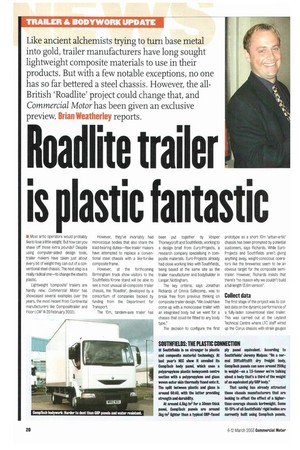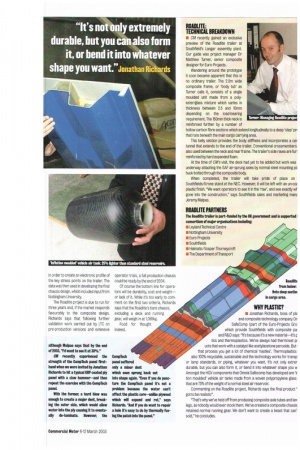SOUTHFIELD& THE PLASTIC CONNECTION
Page 20

Page 21

If you've noticed an error in this article please click here to report it so we can fix it.
• Seuthfleids is no stranger to plastic and composite material technology. At last year's NEC show it unveiled its CompTech body panel, which uses a Polypropylene plastic honeycomb centre section with a polypropylene and glass woven outer skin thermally fused onto it. The split between plastic and glass is around 60:40, with the latter providing strength and durability.
At around 4.5kg/m3 for a 30mm thick panel, CompTech panels are around 3kg/m3 lighter than a typical GRP-faced
ply panel equivalent. According to Southfields Jeremy Malpas: On a normal 2Rftx8ftx8ft dry freight body. CompTech panels can save around 250kg in weight—on a 7.5-tonner we're talking about a body that's a third of the weight of an equivalent ply/CRP body."
That saving has already attracted those chassis manufacturers that are looking to offset the effect of a higherthan-average chassis kerbweight. Some 10-15% of all Southfields' rigid bodies are currently built using CompTech panels, although Malpas says that by the end of 2003,1d want to see it at 30%."
CM recently experienced the strength of the CompTech panel firsthand when we were invited by Jonathan Richards to hit a typical CRP coated ply panel with a claw hammer—and then repeat the exercise with the CompTech panel.
With the former, a hard blow was enough to create a major dent, breaklug the outer skin, which would allow water Into the ply causing it to eventually de-laminate. However, the CompTech panel suffered only a minor dent which soon sprung back out into shape again. "Even If you do puncture the CompTech panel it's not a problem because the water can't affect the plastic core—unlike plywood which will expand and rot," says Richards. "And if you do want to repair a hole it's easy to do by thermally fusing the patch into the panel."




































































































































































